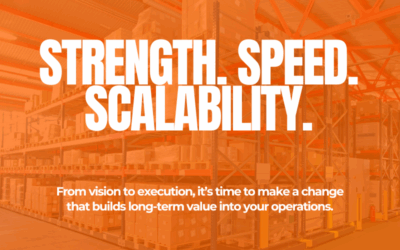New Year, New Layout: Top Tips for Optimizing Your Warehouse in 2025
As another new year begins, you have a fresh opportunity to look critically at your warehouse operations and identify ways to improve. You’re probably asking yourself how you can increase efficiency, maintain cost-effectiveness, and ensure that your storage space is truly working for you. The truth is, whether you’re dealing with changing customer demands, expanded product lines, or simply feeling the pressure of rising overhead, the start of a new year is the perfect time to re-examine your warehouse layout.
In 2025, your warehouse can’t just be a place to store goods. It needs to function as a well-oiled machine—streamlined, organized, and designed to keep your operations running smoothly. When you take steps to optimize your warehouse layout, you’re not just clearing up some space; you’re paving the way for faster order fulfillment, better inventory tracking, reduced labor costs, and ultimately, a more profitable bottom line. So where do you begin?
Below, you’ll find practical tips and proven strategies to help you kick off 2025 with a more efficient warehouse. Think of it as your blueprint for evaluating your current setup, making meaningful changes, and ensuring that your storage solutions are primed for the opportunities this year will bring.
1. Start with a Detailed Assessment of Your Current Layout
Before making any changes, you need to fully understand what’s working in your warehouse—and what’s not. Walk through your facility with fresh eyes, or better yet, bring in a trusted team member who can give you an honest assessment. Look at how products flow through your space from the moment they arrive until they ship out. Are certain aisles crowded, while others seem underutilized? Are high-demand products tucked away in hard-to-reach areas?
Taking a top-down view of your warehouse helps you identify inefficiencies you might have overlooked. Maybe your receiving area is too far from your main storage racks, causing forklifts to make unnecessary trips. Perhaps your picking area is poorly organized, forcing your employees to take longer routes to fulfill orders. By mapping out the flow of goods, personnel, and equipment, you can spot these problem areas and start planning your improvements.
2. Consider Adjusting Aisle Widths and Traffic Patterns
One of the simplest and often most overlooked aspects of warehouse optimization is adjusting your aisle widths. If your aisles are too wide, you may be wasting valuable square footage that could support additional racks. If they’re too narrow, you run the risk of creating traffic jams or accidents as forklifts and pallet jacks maneuver through tight spaces.
You’ll want to strike a balance that maximizes your storage density while still allowing safe, efficient movement. Consider one-way aisles to reduce congestion or designate pedestrian-only lanes to separate foot traffic from equipment. By refining how you route people and machines, you’ll help prevent delays, improve safety, and ensure a smoother flow of goods.
3. Invest in the Right Racking Solutions
Your racking system is the backbone of your warehouse. The type and configuration of your racks can influence everything from storage capacity to picking efficiency. As you rethink your layout, ask yourself what kind of racks best suit your inventory and fulfillment methods. Do you need selective pallet racks for quick, direct access to a variety of SKUs? Or perhaps drive-in or push-back racks to maximize storage density for large quantities of the same product?
Used racking might be an excellent option to consider. Many businesses associate “used” with “inferior,” but that’s a misconception. High-quality used racks can provide the same durability and reliability as new ones—at a fraction of the cost. By exploring used racking solutions, you can upgrade or reconfigure your warehouse without blowing your budget. Plus, quicker lead times and immediate availability mean you can adapt more rapidly to changes in demand.
4. Leverage Data and Technology for Continuous Improvement
In today’s data-driven world, your warehouse layout decisions shouldn’t rely solely on guesswork. By incorporating warehouse management systems (WMS) and real-time inventory tracking tools, you gain insight into which SKUs move fastest, which picking routes work best, and how often certain areas bottleneck.
You might discover that frequently ordered items are stored too far away from the packing station, causing unnecessary labor hours. Or, after analyzing your order history, you might realize that you can rearrange SKUs by velocity—placing top sellers in more accessible positions and reducing the time it takes to fulfill orders. With the right data, you can refine your layout repeatedly throughout the year, ensuring it remains optimized as conditions evolve.
5. Embrace a Culture of Efficiency and Continuous Improvement
Optimizing your warehouse layout isn’t a one-and-done task. As customer demands, product lines, and technology shift, so must your storage strategies. Encourage a culture where your team regularly looks for improvements. Train employees on best practices, invite them to share suggestions, and celebrate efficiency gains. The people who work on your warehouse floor every day often have the most valuable insights into what’s working and where you can still improve.
You could implement a feedback loop where employees report bottlenecks or inefficiencies as they encounter them. By listening to their input and taking swift action, you’re more likely to maintain a flexible, high-performing layout that meets your changing needs over time.
6. Consider the Long-Term ROI of Your Changes
Every alteration you make to your warehouse layout should be viewed through the lens of long-term return on investment (ROI). You’re not just adjusting a few aisles or swapping out some racks; you’re investing in your warehouse’s future success. An optimized layout can lead to faster fulfillment times, fewer labor hours, less equipment wear and tear, and a significant reduction in errors.
These efficiency gains translate directly into cost savings and increased profitability. By choosing the right racking solutions, organizing your space efficiently, and leveraging technology, you set yourself up for strong ROI in 2025 and beyond. Even incremental improvements can add up quickly, giving you a competitive edge in a market that rewards agility and responsiveness.
7. Don’t Hesitate to Seek Expert Guidance
If optimizing your warehouse layout feels overwhelming, remember that you don’t have to do it alone. Bringing in an external consultant or working with a company that specializes in warehouse optimization—like Richmond Rack—can save you time, money, and headaches. Experts can conduct a thorough assessment, recommend racking configurations tailored to your operations, and guide you in selecting used equipment that meets industry standards while staying within your budget.
When you have seasoned professionals in your corner, you’ll gain peace of mind knowing that your layout adjustments are rooted in best practices and backed by decades of experience. Plus, you can fast-track the optimization process, putting your new, improved warehouse layout to work sooner.
Take Action and Start 2025 on the Right Foot
This new year presents a golden opportunity. By taking a critical look at your current layout, adjusting aisle configurations, upgrading your racking, harnessing data-driven insights, and fostering a culture of continuous improvement, you’re well on your way to creating a warehouse that supports your business goals rather than holding them back.
Don’t let the chance for a fresh start slip by. You now have the tools and understanding to make meaningful changes. The final step is taking action. Consider consulting with experts who can assess your space and recommend solutions. Explore used racking to boost capacity and efficiency without breaking the bank. And, most importantly, commit to ongoing evaluation so your warehouse never falls behind again.
Ready to make 2025 your most efficient year yet? Contact Richmond Rack for a personalized consultation and let our experienced team help you optimize your warehouse layout for peak performance.


